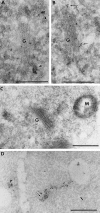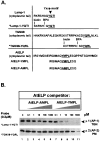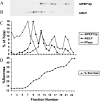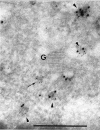A putative vacuolar cargo receptor partially colocalizes with AtPEP12p on a prevacuolar compartment in Arabidopsis roots
- PMID: 9707576
- PMCID: PMC21437
- DOI: 10.1073/pnas.95.17.9920
A putative vacuolar cargo receptor partially colocalizes with AtPEP12p on a prevacuolar compartment in Arabidopsis roots
Abstract
Targeting of protein cargo to the vacuole/lysosome is a multistep process that appears to have conserved features between mammalian, yeast, and plant cells. In each case, some soluble vacuolar/lysosomal proteins are believed to be bound by transmembrane cargo receptors in the trans-Golgi network (TGN) that redirect these proteins into clathrin-coated vesicles. These vesicles then appear to be transported to the prevacuole/endosome by a trafficking machinery that requires components identified in other vesicle-targeting steps such as N-ethylmaleimide-sensitive factor (NSF), soluble NSF attachment protein (SNAP), SNAP receptors (SNAREs), rab-type GTPases, and Sec1p homologs. Two likely members of this trafficking machinery have been characterized from Arabidopsis thaliana: AtPEP12p, a t-SNARE that resides on a what we now call a prevacuolar compartment, and AtELP, a protein that shares many common features with mammalian and yeast transmembrane cargo receptors. Here, we have further investigated the intracellular distribution of AtELP. We have found that AtELP is located at the trans-Golgi of Arabidopsis root cells, and that its C terminus can preferentially interact in vitro with the mammalian TGN-specific AP-1 clathrin-adapter complex, suggesting a likely role in clathrin-coated, vesicle-directed trafficking at the TGN. Further, consistent with a role in trafficking of vacuolar cargo, we have found that AtELP partially colocalizes with AtPEP12p on a prevacuolar compartment.
Figures




Similar articles
-
The plant vesicle-associated SNARE AtVTI1a likely mediates vesicle transport from the trans-Golgi network to the prevacuolar compartment.Mol Biol Cell. 1999 Jul;10(7):2251-64. doi: 10.1091/mbc.10.7.2251. Mol Biol Cell. 1999. PMID: 10397763 Free PMC article.
-
The t-SNARE AtVAM3p resides on the prevacuolar compartment in Arabidopsis root cells.Plant Physiol. 1999 Nov;121(3):929-38. doi: 10.1104/pp.121.3.929. Plant Physiol. 1999. PMID: 10557242 Free PMC article.
-
The pre-vacuolar t-SNARE AtPEP12p forms a 20S complex that dissociates in the presence of ATP.Plant J. 1999 Sep;19(5):599-603. doi: 10.1046/j.1365-313x.1999.00552.x. Plant J. 1999. PMID: 10504581
-
Receptor-mediated sorting of soluble vacuolar proteins: myths, facts, and a new model.J Exp Bot. 2016 Aug;67(15):4435-49. doi: 10.1093/jxb/erw222. Epub 2016 Jun 4. J Exp Bot. 2016. PMID: 27262127 Review.
-
SNAREs and membrane fusion in the Golgi apparatus.Biochim Biophys Acta. 1998 Aug 14;1404(1-2):9-31. doi: 10.1016/s0167-4889(98)00044-5. Biochim Biophys Acta. 1998. PMID: 9714710 Review.
Cited by
-
Identification of multivesicular bodies as prevacuolar compartments in Nicotiana tabacum BY-2 cells.Plant Cell. 2004 Mar;16(3):672-93. doi: 10.1105/tpc.019703. Epub 2004 Feb 18. Plant Cell. 2004. PMID: 14973159 Free PMC article.
-
Dynamic localization of rop GTPases to the tonoplast during vacuole development.Plant Physiol. 2001 Jan;125(1):241-51. doi: 10.1104/pp.125.1.241. Plant Physiol. 2001. PMID: 11154333 Free PMC article.
-
Sorting inhibitors (Sortins): Chemical compounds to study vacuolar sorting in Arabidopsis.Proc Natl Acad Sci U S A. 2004 Jun 22;101(25):9497-501. doi: 10.1073/pnas.0402121101. Epub 2004 Jun 9. Proc Natl Acad Sci U S A. 2004. PMID: 15190181 Free PMC article.
-
Demonstration in yeast of the function of BP-80, a putative plant vacuolar sorting receptor.Plant Cell. 2001 Apr;13(4):781-92. doi: 10.1105/tpc.13.4.781. Plant Cell. 2001. PMID: 11283336 Free PMC article.
-
Sorting and anterograde trafficking at the Golgi apparatus.Plant Physiol. 2008 Oct;148(2):673-83. doi: 10.1104/pp.108.124925. Plant Physiol. 2008. PMID: 18838501 Free PMC article. No abstract available.
References
Publication types
MeSH terms
Substances
Grants and funding
LinkOut - more resources
Full Text Sources
Other Literature Sources
Molecular Biology Databases
Miscellaneous

